Thanks for visiting Narrative Nation!
Some of this will be incorporated into the book I’m developing with the working title “Loads of Heresy”: Far Right Revisions of the American Narrative.
Though I write about some current political events related to my subject here, this is mainly where I collect thoughts and images from my own exploration of places with emotional significance for many Americans. So far, stops include Civil War and Revolutionary War sites and museums; Underground Railroad sites; state parks and historic homes; historical associations; and memorabilia and gun shops. To get a better sense of the narratives attached to historic places and the events and people they commemorate, I look at the signage, collect the literature, and talk to visitors, staff, guides, and rangers. And of course, I mine the gift shops! Other places such as a Christian theme park, a convenience store, and a gun and knife show help me consider how ideas about history influence current American fascinations, conspiracy theories, and cultural conflicts.
Narrative Nation is free to read, though paid subscribers are deeply appreciated and enable me to spend more time doing writing and less time teaching writing. Restacks also really help me grow my readership. Thank you for being here!
I saw this t-shirt in the White House of the Confederacy gift shop—a stop I won’t cover until a later story—but it seems like a good enough way to start a new series from last summer’s road trip.
The city of Richmond, Virginia and its immediate environs are my hometown, generations deep. Centuries, actually. Cue the obligatory reminder that we were the capital of the Confederacy. Cue memories of ignorant suburban teenagers exaggerating their Southern accents with Southern accents as they called out Douglas Southall Freeman! The South’s gonna rise again! Saaaa-luu! in the smoking section outside a high school named after the Pulitzer-winning biographer of Robert E. Lee. But I’ll get back to all that as I go.
After leaving Boone County, Northern Kentucky, where I explored important sites of enslavement and the Underground Railroad as well as the absolutely bonkers 75,000 sf Creation Museum, I stopped in Charleston, West Virginia for the night. The next day I took a run around that interesting riverfront area, got way off on my driving schedule, and finally reached Richmond by late afternoon. Though I had reserved a hotel in the historic Shockoe Bottom district, I instinctively jumped off the highway at the first real exit into the city a few miles west of there.
The moment I turned onto the street that used to be called the Boulevard and drove past the stadium that used to be called Parker Field and used to have a giant sculpture of an Indian brave climbing over the exterior wall, I was home. What a sweet feeling is that. But Richmond has changed a lot in the 22 years since I lived there. And what a sweet feeling that is, too. This is the first in a series of stories I’ll slowly get written to capture a small part of the artful and thoughtful progress Richmond has made in its public narrative, and also to look at some of the revisions that still need addressing, now even more noticeable in contrast.
I drove up past Scott’s Addition on what’s now called Arthur Ashe Boulevard (more to come on that too), crossed Broad Street into the Fan district, and turned left onto Monument Avenue. But I almost missed that turn because there was no longer a monument at the intersection of Monument. I hadn’t been there since the neighborhood made national news while removing the most famous set of Confederate statues in the country.
From Florida, I had cheered it on, read all the media coverage, watched my local friends’ Facebook pages, and even incorporated it into my writing classes. Still, my chest was a little tight as I prepared to see this street that anchors so much of my memory so fundamentally changed. Like that unsettling feeling in some dreams when you know for sure where you are but it looks completely different.
But it didn’t look completely different. The enormous columned houses and apartment buildings in so many styles, all standing so close together, the churches, and the huge grass median are what give this 140-foot wide avenue a continuing identity. It’s a beautiful street. Every inch of it fascinates. (Old friends in Richmond reading this and saying nope: I think you’re just used to it, to the whole gorgeous and complicated place that is the Fan.) To be sure, the grand avenue continuing west of Franklin Street was planned as a paean to the Confederacy and a way to signal the city’s prominence in the South. But back inside the place itself, I remembered that Richmond doesn’t have to be a story “about” these Confederate monuments.
As a young person, my primary relationship to the monuments was hanging out on their pedestals and lawns like any other park space. Of course I knew they were Civil War statues, but somehow I made it through my younger years without realizing that heroes from only one side of the war were represented. At the private school I attended, there was a studied “polite silence” on issues of race, segregation, and the Civil War. And once I understood that these were memorials to the South only, it was much longer still before I understood the role they played implanting the Lost Cause narrative and signaling, in just about the clearest way one can think of, support for segregation. But the original intentions of the neighborhood’s permanent sets and backdrops had little bearing on my own daily dramas in the 1980s and 1990s in my teens and early twenties. As I gradually became more historically literate and politically engaged, their shadows lengthened and darkened. And then for years they threatened to overwhelm the story of my city.
But when I passed back through this summer, the sites where the monuments had been so conspicuously located were just there, relieved to quietly grow grass after a century of being used to hawk a disingenuous version of the national narrative. And the circles were so much smaller than I would have drawn them. I’ll write more about the downed statues themselves in a later story.
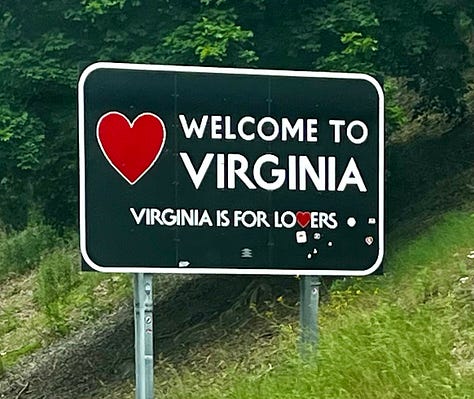

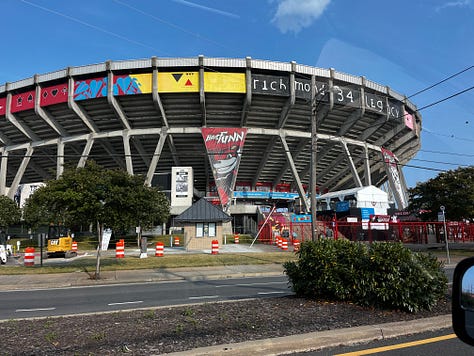
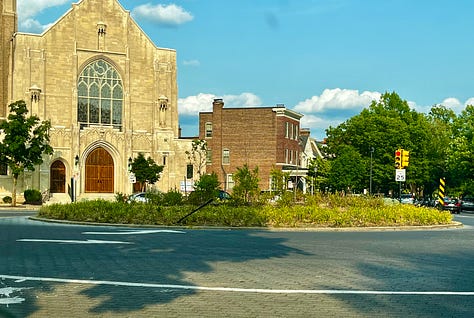


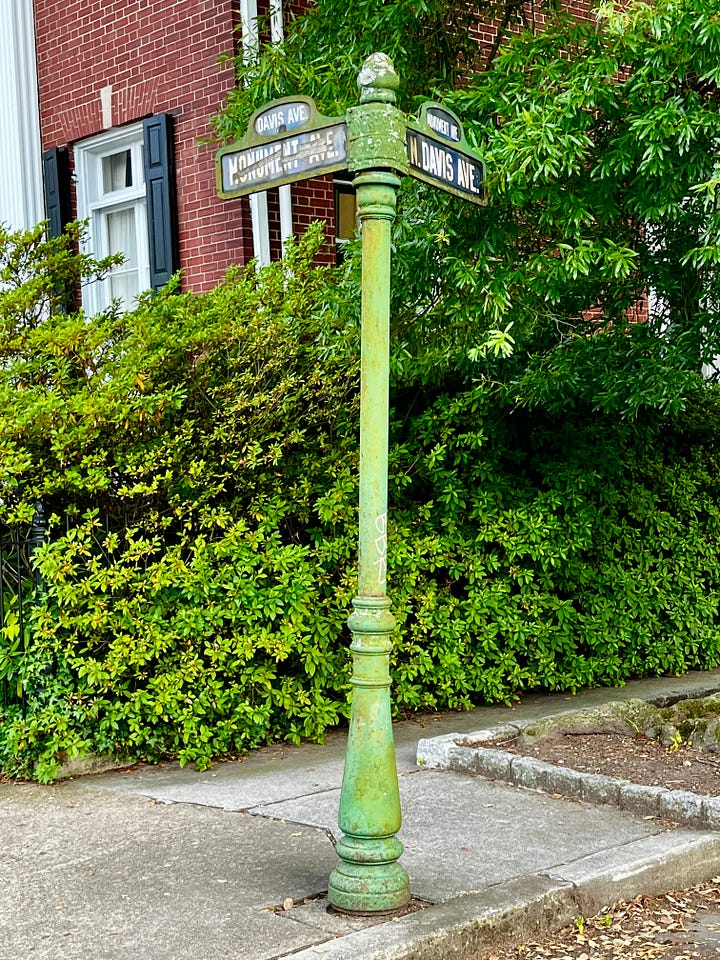

There wasn’t anything to see on the topic of Confederates on Monument Avenue itself that day: that’s the point. So I drove around for a while absorbing what Virginia Commonwealth University has done to/with the Lower Fan and Cary and Broad Streets. I took my time rolling past some favorite buildings, places, and neighborhoods that had always captured my imagination more than those Confederate statues: Oregon Hill, Jackson Ward, Court End, Shockoe Slip, Tobacco Row, Shockoe Bottom, Church Hill, Chimborazo Park. I double-parked to take pictures of apartments and houses I lived in. I drove to Hollywood Cemetery where my childhood best friend was buried when we were 17.
I’ve been trying to write this post for days. I’ve wanted to mark all the connections that came to me, tell my own story, my dad’s family story, find out about things I never new, and try to find out how it was I could not have known them. I even started to write a Wikipedia article about an important Richmond thing that doesn’t have one yet. But after writing thousands of words and reading many more, and generally making a holy mess of things for now, I decided to post something more like an introduction.
The rest of the series hopes to organize itself much better. In the next post, “the memory of its chieftains,” I reflect on a few of the public voices that have influenced, for better and for worse, the way the city has told its story and look at several important sites of renaming and removal. I also wonder how it is that one school’s name has yet to be changed. Other stories will look at some instructive juxtapositions of old and new ways of telling Richmond’s story as I describe what I saw and heard at sites including Browns Island and Belle Isle; Tredegar Iron Works and the new American Museum of the Civil War; the White House of the Confederacy and the Valentine Museum; Quality Row, Black Wall Street, and the Museum of Black History and Culture in the old Armory Building; and the intersection of old and new on Arthur Ashe Boulevard. Much of what I found in Richmond’s response to its Confederate history is, like my favorite parts of any culture, irreverent and fun.
Of course I’ll have to meander at least a bit in my personal thoughts about this beautiful city on the James River. It’s a commonplace to hear how this is the only site in the country where Class IV rapids flow through a major city. The story of Richmond does include that power. But my own James River is also a place where an intrepid child could get all the way across on the huge gentle rocks—or stop in the middle and spend the day drawing and painting on them.
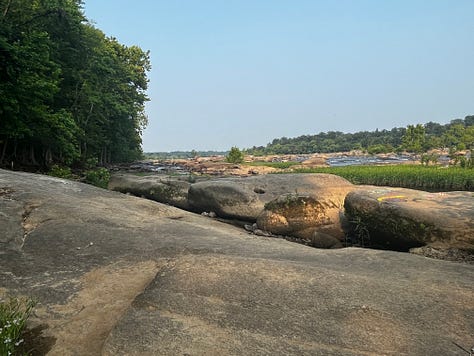
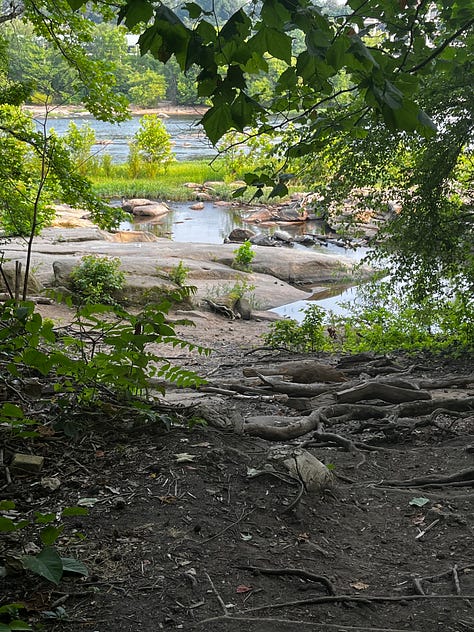
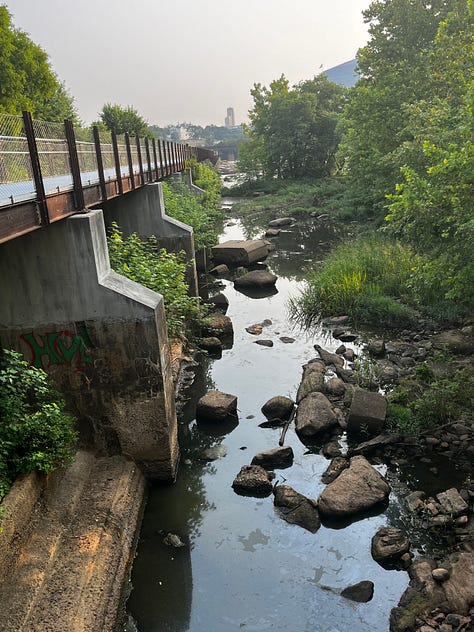
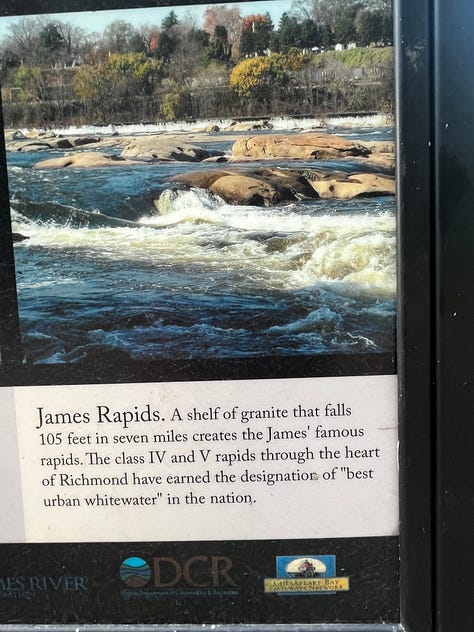
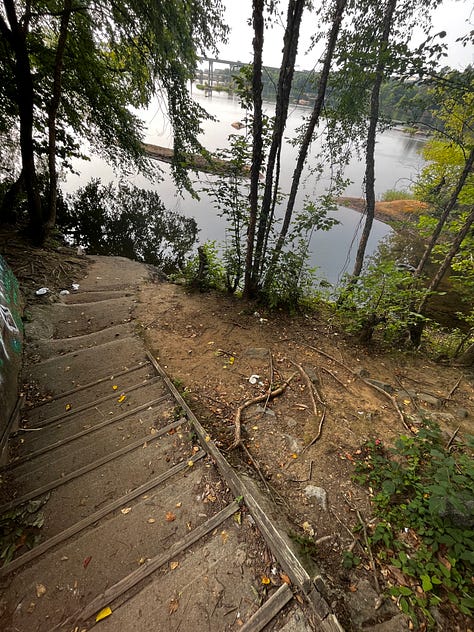
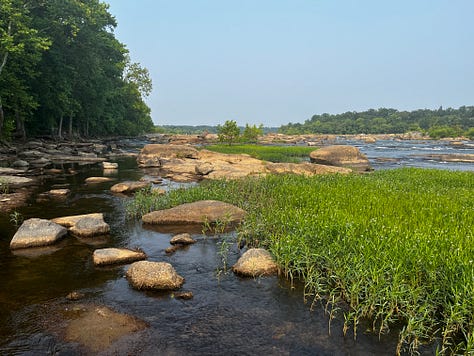
So I will write about my family’s hometown with impunity, making and not deleting connections that will mean more to me than they do to the world. There’s a useless photo essay coming, to include all the houses where I ever lived and a surreal surprise discovery related to that. But I’ve been kind of homesick for twenty years, and it’s like a line from Steely Dan: “I cried when I wrote this song, Sue me if I play too long.”




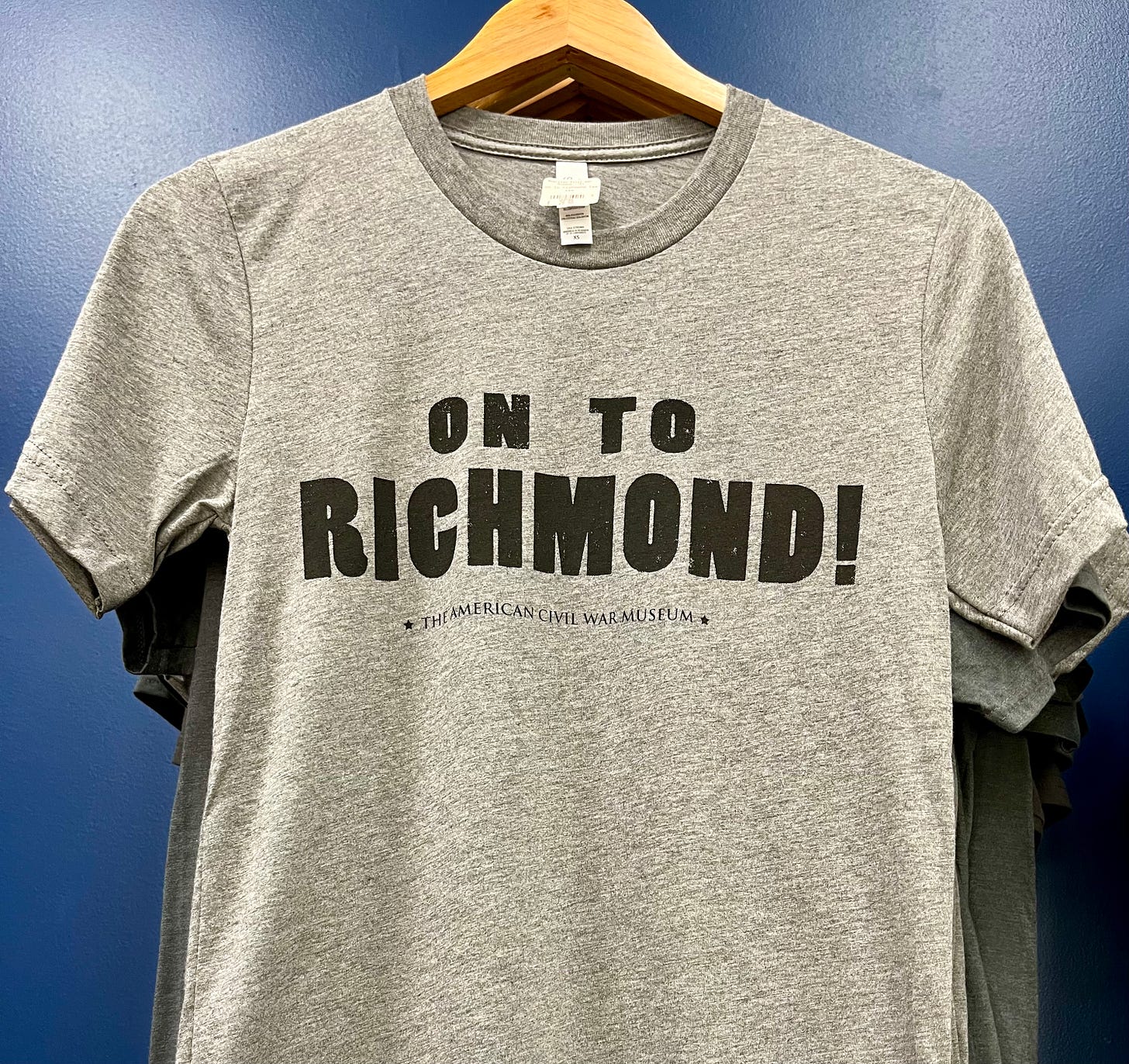
Wonderful writing Laura! Looking forward to the next post!
What a wonderful feeling it must be to return to your hometown and find it so miraculously and progressively changed. A better development, perhaps, than those most quoted lines from T.S. Eliot's "Little Gidding." Yet also, "We are born with the dead: / See, they return, and bring us with them." As I've said before, your youthful experience to these monuments is so punk rock. Yet we head into the second half century of our lives, an even more turbulent time than maybe we thought we lived in when young, and if arises "The Second Lost Cause," this one prior to, as opposed to the first, a Civil War, Richmond may be a very good place to be. I envy your rediscovery of your hometown. When I used to hear people say, "The South will rise again," I didn't realize it could happen this way.